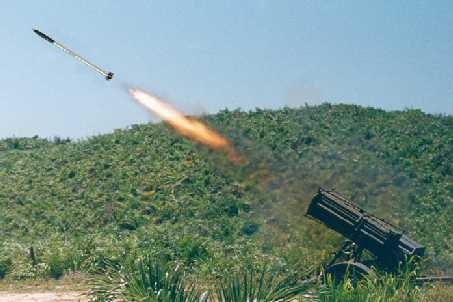Afghanistan.
Deadlock between Northern Alliance forces and the Islamofascist Taliban has reverted to WWI-style trench warfare. A breakthrough is needed to take the key crossroads city of Mazir-e-Sharif for Russian supplied and sometimes manned T-55 medium and BMP-2 light tracked tanks to move ahead. With a new supply of 107mm rockets, the freedom fighters fire salvo after salvo from towed launchers into the distant rocky heights ahead, breaking up the Taliban resistance, as their tracked juggernaut moves ahead. Taliban lines broken, the penetration becomes a pursuit as the enemy flees from city to city. The eventual result is Afghanistan is freed from the oppressive Taliban.
Rockets.
Why do our enemies and allies realize their value for ground bombardment such that they are made available in lightweight ground mounts to achieve effects in difficult terrains and we do not?
Weapons futurist Phil West does a superb job outlining how many armies are using short-range rockets to devastating effect--most are actually in COMBAT today and necessity is the "mother" for their inventions. The west, at peace are lagging behind.
Phil West's Mini-MLRS web page
Rockets: a brief history
In his excellent paper, "MLRS: a rocket system for the marine corps", Major C. W. Morris, USMC tries in vain to get marines to use ground-fired rockets, he states:
"While the use of rockets as early as 1232 A.D. by the Chinese has been documented, the employment of rockets for surprise, psychological, and shock effects has been debated continually since that time.In 1814, Sir William Congreve had written of the theory of rocket system employment. In his writings he discussed the facility of firing a great number of rounds as quickly as possible, thereby advocating the capability of massing fires and the benefits that accrue to a rocket system. He stressed two characteristics: the simplicity of a launcher and, primarily, its capacity to mass fires on a large target instantaneously, thus affecting total surprise on the enemy. In the 1980's his theories on the tactical employment of rocket launchers are still valid.
Over the centuries the employment of rockets as a weapon system has been refined until, looking at modern day examples, we begin to see extremely effective systems utilized by many nations of the world. Most effective, both in capabilities and numbers, have been the Warsaw Pact systems. There are other examples, including the West German Light Artillery Rocket System (LARS) and the U.S. Army Multiple Launch Rocket System (MLRS); but it is the Soviets who have used these systems continually and effectively for the greatest period of time.
Due to the fact that Soviet arms sales have proliferated to a great degree since World War II, the probability of meeting the armed forces of a country equipped with rocket systems, whether in low, medium, or high intensity conflict, is very great. Does the marine corps require a rocket system to provide a massing and counterfire capability to meet such a threat? The answer is, unequivocally. "Yes!"
Since that time many refinements in the systems employed by all users have evolved. The greatest benefits derived from the use of early rocket systems were the instantaneous mass destruction capabilities, as well as the psychological surprise and shock effects. Many of the early systems were not accurate or stable and resulted in more danger to the users than the enemy recipients. Rockets were used throughout Europe in the 19th century and in the Civil War of the United States.
As the 19th century ended and the 20th began, interest in rockets waned until the 1920's and 1930's, when developmental periods were begun by Germany and Russia. The first significant rocket use in modern times was undertaken by Germany in World War II. Russia followed closely with its own development and use of rockets. The German system had a range of 7850 meters and the Russian model, BM-13, had a range of 8500 meters. The Russians continued development following World War II, culminating in the BM-21 and BM-27 which are well known today. The BM-21 is a 122mm system with a range of 20 kilometers and the BM-27 is a 240mm system with a range of 40 kilometers.
Early U.S. Army systems developed prior to and during World War II included the 2.36 and 3.5 inch anti-tank rockets, as well as the 4.5 inch surface-to-surface rockets. The 4.5 inch system was developed in several configurations, all of which were used extensively by both the Army and the marine corps. Maximum achievable range of the 4.5 inch launchers was 5250 yards. Marine utilization was an off-shoot of Navy use in support of amphibious assaults.
Interest in these systems was reflected by numerous written articles following World War II, and their use continued on through the Korean Conflict where rocket batteries were depended upon heavily and used with great effectiveness. Interestingly enough, these launchers were used in conjunction with helicopter transport providing tactical mobility and resupply to the rocket units, which documents the first use of helicopter movement of supporting arms to a forward position of employment.
Several articles in the marine corps Gazette in 1952 and 1953 extolled the virtues of the employment of rocket systems. Some of the advantages enumerated included reinforcing the fires of direct support artillery as well as the ability to surprise the enemy with massed fires. One of the biggest disadvantages noted was the signature of the rocket launchers when firing. This appears to be a major disadvantage of systems in use today. As a result, special sets of tactics and techniques were developed, which are still in use.
Following Korea, interest in rockets in the marine corps began to decline, primarily due to the increased weight required to extend the range. The only other modern experience of note for the marine corps was to be found on the receiving end of rockets during Vietnam, where the Viet Cong's use of Soviet rockets, while not highly effective in producing damage [WRONG. Ask the grunts at Khe Sanh], did have some effect on morale.
Following the Korean Conflict, while assessing the high intensity need for a tactical nuclear system with extended range for use in the European theatre, the Army began development which eventually lead to the Lance and Pershing missile systems. However, Army interest in rockets did not totally abate, and, eventually, a conventional, general support artillery rocket system was seen as a requirement in the early "70"s. Due to the increased Warsaw Pact threat facing the Army in Europe, a need was forseen to be able to attack critical, time-sensitive targets. In the early-to-late `70's, the Army became interested in the Slammer, a series of 2.75 inch aerial rocket pods mounted on a trailer. Due to questionable lethality and range, interest in this system disappeared.
Following developmental testing, the Army acquired the MLRS in 1981. Around the same time period marine interest was centered upon the Field Artillery Rocket System (FARS), 5-inch Zuni rocket pods mounted on a trailer, and the Hydra, a system incorporating pods of 2.75-inch rockets. Although accused by individuals as "misguided interest", a real need for a mass destruction weapon system was perceived in the marine corps. Unfortunately, short range and lethality raised questions that resulted in the marines' decision to drop the FARS and Hydra. In the mean time, the Army culminated its efforts in the early `80's by awarding a contract and acquiring the MLRS. The need for a rocket system of this type was recognized by the marine corps at this time, but remained unfulfilled.
Before continuing, a description of the system the Army acquired is in order. The MLRS is a tracked, self-propelled, all-weather, rocket system capable of launching twelve 227 millimeter rockets in a single ripple of approximately 60 seconds, or engaging targets individually with a single rocket. The armored Self-Propelled Loader-Launcher (SPLL) is operated by a crew of three men and provides an automated positioning and firing capability. Its on-board communications system and fire-direction computer are digital, and provide a burst transmission link to higher and adjacent headquarters. It is produced by the LTV Corporation and is presently able to deliver 644 (M77) anti-material/anti-personnel grenades (Dual Purpose Improved Conventional Munitions) per rocket.
It is air transportable by both the C-141 and C-5A aircraft. It is highly mobile and is designed to augment cannon artillery in its suppression, counterfire and interdiction roles. It may be used in the general support (GS), general support-reinforcing (GSR), or reinforcing (R) role as an indirect fire area artillery weapon system. The inherent responsibilities of each of these missions are similar to those for tube artillery. It will provide additional firepower while freeing tube artillery units for the direct support (DS) role. Its present range is 30+ kilometers (unclassified), but with the advent of munitions currently undergoing development, its range will increase to 100+ kilometers.
The Army is presently organized utilizing the MLRS battalion (3 batteries of 9 launchers each) as a corps asset, either independently deployed or attached to a field artillery brigade within the corps. The battalion is organized to provide rocket fires in support of the corps, as well as to reinforce other corps artillery units. In addition, an MLRS battery (9 launchers) is organic to the divisional artillery (DIVARTY) of the Army's heavy divisions (mechanized and armored). This provides general support fires for the division. The batteries which are organic to the DIVARTY are virtually identical to those within a Corps MLRS battalion.
The concept for employment of the MLRS is GS and GSR at the DIVARTY level while the battalion can be used in a R, GSR, or GS role at the Corps level. It can be used not only for the attack of deep, high payoff targets, but also to augment tube artillery suppression of enemy air defense, counterfire, and interdiction. Its value in augmenting tube artillery by providing additional firepower is made evident when considering that one rocket with 644 submunitions equals 7.3 rounds of 155mm (88 submunitions per round) or 3.5 rounds of 203mm (182 submunitions per round). This equates to a single launcher with 12 rockets equalling or exceeding the massed firepower (one round per tube) of 11 batteries of 155mm howitzers or 7 batteries of 203mm howitzers. While the overall concept is to augment the fires of tube artillery, it must be noted here that the 203mm howitzer is reaching the end of its service life. It is the intent of the Army to eventually replace all 203-mm howitzers with MLRS.
Having noted the Army's success with MLRS, and the marine corps' interest (or lack thereof) in rocket systems following Korea...."
WWII and Korea: Americans used ground rockets
Americans used vehicle-mobile 4.5" rockets for bombardment in WWII and Korea following the lead of the German Nebelwerfer and Russian Katyushas called "Screaming Meamies". Rockets were mounted on towed launchers, on truck beds and even on top of M4 Sherman tank turrets. Somehow along the way into the "nuclear" and "missile" age we have forgotten the need to saturate bombard an area with rockets for ground maneuver attacks and we've paid for it dearly in lives. While we can and should mount 2.75" Hydra-70mm rockets on aircraft, the fact remains an aircraft has to fly in the air and has a limited amount that can be carried. While an aircraft might be able to get a line-of-sight (LOS) to see and hit a target masked from view on the ground (CAS/MAS) it will not be likely to bombard large targets to suppression let alone destruction. Tube artillery is an important means to get area supressive effects to free maneuver, but with the cancellation of the autoloaded Crusader 155mm SPH system, rounds fired by hand is still the norm resulting in a slow impact of shells on the enemy who can move and avoid fire effects. For a sudden, surprise bombardment, that catches the enemy you need rockets.
The U.S. Army has the large Bradley-based tracked MLRS 227mm (12-shot) rocket system mounted on a tracked and wheeled truck HIMARS (6-shot) vehicle with a range in excess of 30 kilometers but these systems are cumbersome to use in difficult terrain where C-130 delivery followed by cross-country movement is required and cannot fire at targets shorter distances away, from 1-10 kilometers. Big rockets can't shoot short! We can and we should mount the HIMARS 6-pack of 227mm rockets onto a parachute airdroppable 10.5-ton M113A3 Gavin light tracked AFV with a cargo bed called the XM1108 to achieve long-range rocket fire capability.
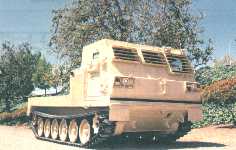
However, we also need a shorter range rocket system that is towed by a M113A3 Gavin, HMMWV truck or M973A2 Ridgway armored SUSV that can be helicopter lifted into battle. Carlton Meyer and Mike Sparks have called repeatedly for Air Defense Artillery Avenger HMMWV trucks to take advantage of their ability to mount pods to fire 2.75" Hydra-70mm rockets for ground shock action but the Air Defenders don't want to contribute to the ground fight. Not in their "job description".
In our book, "Air-Mech-Strike: Asymmetric Maneuver Warfare for the 21st Century" we describe a trailer version of the MLRS 6-pack rocket launcher called "T-MARS". This will get lighter units a long-range rocket fire capability to include the ATACMS missile. However, we still need a smaller rocket system, a "T-MARS Junior".
The Brazilians have what we need: the Launcher AV-LM-12/36
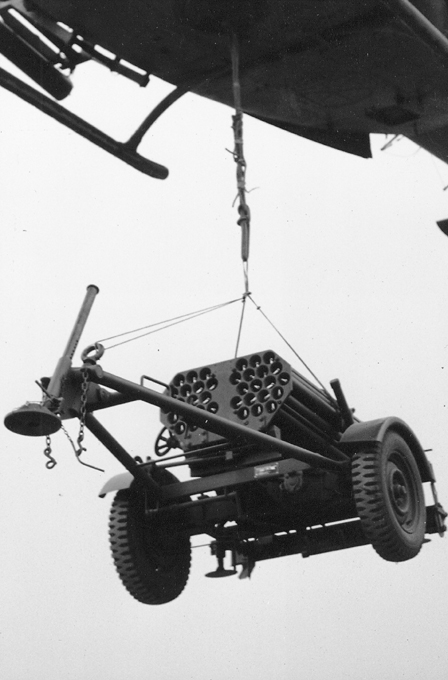
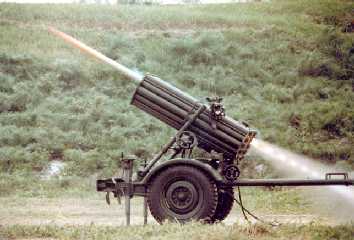
The AV-LM-12/36 saturates an area of 200,000 m2 in less than 12 seconds in a range of up to 12km, thus exploiting the surprise factor.
The AV-LM-12/36 provides Commanders the possibility of increasing significantly, the available organic fire support in determined combat situations actuating, with massive firepower, during the critical phases of an operation. Massed rocket fires create unfavorable tactical conditions accessing high mobility fire support system capable of being employed in all types of terrain and operations, particularly special operations.
Now imagine two force structures for the 82nd Airborne and 101st Air Assault Division using the AV-LM-12/36 as a "T-MARS Junior".
82nd Airborne Division T-MARS Junior Battery
Parachute airdrops T-MARS Junior on Type V airdrop platform as either a towed launcher with wheeled HMMWV truck prime mover or the launcher on the back of an armored XM1108 Gavin tracked AFV. The Gavin T-MARS Junior would be armor protected and more compact volume-wise than the T-MARS Junior towed launcher and HMMWV truck but would be heavier. Both the Gavin and HMMWV prime movers could mount ASP-30mm autocannon weaponry for close-in firepower during movement. The ASP-30mm shoots the same 30mm ammo that the Aviation Brigade's OH-58D Kiowa Warriors and AH-64 Apaches shoot, and of course the same 2.75" Hydra-70 rockets.
Upon landing in the Drop Zone, the T-MARS Junior would be derigged and placed into action to fire and destroy immediate threats to the airhead out to 12 kilometers by saturation fire and destroy point targets with guided Hydra-70 rockets by a COLT Team lazing the target. Carlton Meyer describes how laser-guided 2.75" rockets could be the new "bazooka" for 21st Century Army forces.
101st Air Assault Division T-MARS Junior Battery
Helicopter sling-loads T-MARS Junior towed launcher and HMMWV prime mover truck by UH-60L Blackhawk helicopter or rolls on/rolls-off the T-MARS Junior on the back of the M973A2 Ridgway armored SUSV (BV-206S) from the inside of a CH-47D Chinook helicopter. The M973A2 could also tow a T-MARS Junior launcher.
Both the Ridgway and HMMWV prime movers could mount ASP-30mm autocannon weaponry for close-in firepower during movement. The ASP-30mm shoots the same 30mm ammo that the Aviation Brigade's OH-58D Kiowa Warriors and AH-64 Apaches shoot, and of course the same 2.75" Hydra-70mm rockets.
Will the U.S. Army "SEE" the light?
An Army Combat Engineer writes:
"I enjoyed your article regarding the adoption of the Brazilian Hydra-70mm rocket system. I am a Soldier in a combat engineer unit and I had an observaton that I would like to share with you.
The engineers are equiped with a useless piece of equipment called the Small Emplacement Excavator or SEE.
www.geocities.com/tufelhundin/373gear.htm look towards the middle of the page for the picture. Without going into too much detail as why the SEE is a piece of garbage, I located a website that showed what can be done with the chassis should the SEE be scrapped. The Argentine Army does not have the huge budget the U.S. Army has, yet they have, what I think, is the answer to the light artillery question. It is called the Pampero and without having to buy a brand new truck chassis, the SEE can be reconditioned into this configuration or something similar to it."
www.jed.simonides.org/artillery/mbrl/pampero_series/pampero-series.html#variants
It makes sense to us to incorporate a prime mover into the 2.75" rocket launcher and not throw resources away when the truck portion of the SEE becomes available. The Army must stop acting like a bunch of pampered, wasteful bureaucrats who constantly need "toys" from Congress. If they don't get the new toy they want, they shouldn't pout in public or gloat just because its "new"; it may be a deathtrap like the lav3stryker and should be cancelled. Let's keep an eye out and "see" when the SEE is realized as a dismal failure and withdrawn from service...maybe we can save it for use as a 2.75" rocket launcher?
Rocket Launcher AV-LM-12/36
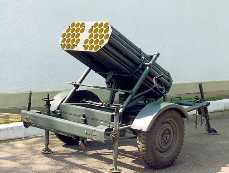
Launcher:
Number of tubes: 36
Weight empty: 950 kg
Length: 3220 mm
Width: 1700 mm
Height: 1200 mm
Time to occupy position: Less than 5 minutes
Full ripple time: Less than 12 seconds
Time to scoot: 3 minutes
Time to re-load: 15 minutes
Rockets:
Designation: Skyfire 70
Caliber: 70mm (2.75")
Rocket motor: M10, with solid composite propellant
Stabilisers: 4 wrap-around fins
Warheads: High Explosive, Multiple with 6 submunitions, Flechette, White
Phosphorous, among others
Max. range: 12, 000 meters
Total length: Max. 2000 mm depending on Warhead
Total weight each Rocket incl. Warhead: Max. 14.6 kg.
www.army-technology.com/contractors/missiles/avibras/

Rodovia dos Tamoios, Km 14
P.O. Box 278
CEP 12300-000
Jacareí, SP
Brazil
Tel: +55 12 3955 6000
Fax: +55 12 3951 6277
E-mail: pre@avibras.com.br
URL: www.avibras.com.br
FEEDBACK!
Field Artillery and Vietnam combat veteran LTC Larry Altersitz writes:
"Add a 4-launcher platoon to a DS 105mm howitzer battalion and you have a great light area suppression capability. Put a second layer on top for more capability. Heck, be able to independently lay the upper pair in a second direction (15 degrees either side of the azimuth of lay) and then watch the fun. Put in the back of a Hummer and use it as a mini-MLRS.
Oh, by the way.....
Had an article published in the May-June 1980 INFANTRY (!!!) where I suggested a frame with three 19-tube pods of 70mm rockets on a Bradley for fire support, like the WWII Sherman with the 'Calliope' 4.5 inch rocket launcher mount on the turret. I referenced the scene in 'Patton'.
A German weapons futurist LastDingo writes:
"A similar U.S. 70mm MRL exists; it's called RD-MRWS (rapid deployment multiple rockets weapons system).
It consists of a trailer with six pods for each 19 rockets. Those pods are identical to those used by Apaches and Cobras - overall it's just the costs for the rockets and the trailer if the U.S. Army wants to adopt the weapon.
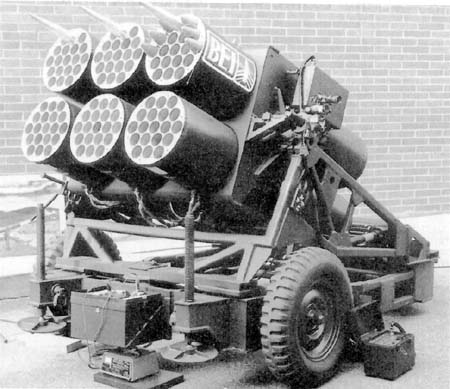
Is the RD-MRWS the "Slammer" Major C.W. Morris was talking about?
Instead, they went for HiMARS, and the already type-classified 70mm MRL remained a prototype.
If you think that both RD-MRWS and the MRL are too heavy, you'll like this one:"
Indonesian 2.75" rocket launcher: only 700 kilograms!
The price of the rockets maybe a horror compared to 81mm mortar shells, but lots of nations have them in storage - and the idea of a relatively simple 'RD-MRWS with electro engines + handheld computer' combination for dragon fire-like remote firing is interesting at least.
All the 'Netfires' vertical-launch stuff would lose against stone age clans, but RD-MRWS is in contact with reality."
Our reply: Totally agree. So now we are in mountain combat in Afghanistan without a short-range MRL. Almost every other Army in the world that has to fight in difficult terrain has small MRLs except the U.S. Army and marines. We are ready to fight another "Desert Storm" in the open at long-ranges with centralized bureaucracy and long-range rockets on heavy and vulnerable wheeled carriers but at shorter ranges in combats in restricted terrains (Mountains, Jungles) where we absolutely must have decentralized small-unit empowerment we are still outgunned by enemy RPGs, small MRLs and mortars.
We must fix this now!
"Research into the war of the future is not, therefore, an idle pastime. It is, rather, an ever-present practical necessity."
--Giulio Douhet, Airpower theorist
